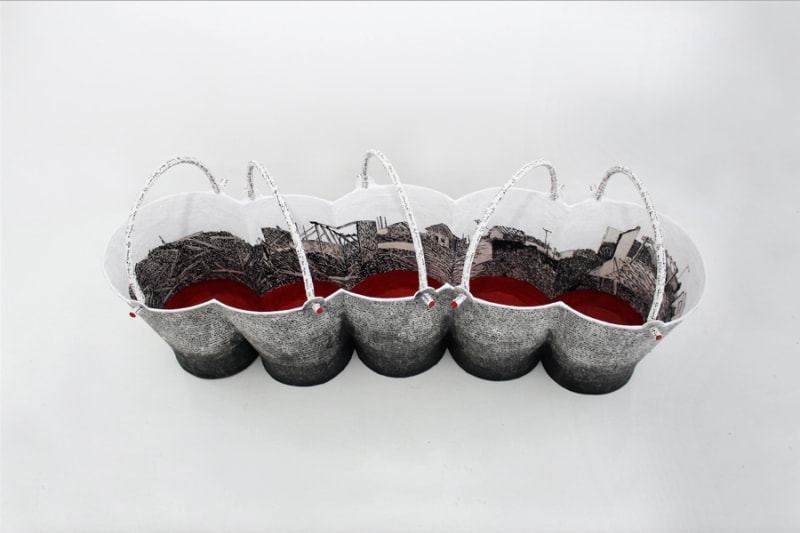Apperceiving 1983 : Gayan Prageeth
As Sri Lanka begins to rebuild itself and attempts at reconciliation begin to take shape, the exhibition “Apperceiving 1983” looks back at the events that transpired between the people of Sri Lanka and the violent effect it had on numerous lives, memories and futures. This show works as a continuation to Gayan Prageeth’s exhibition last year under the sametitle. For him, the work of memorializing is not yet done. These new works continue to speak to the turmoil that preceded and followed the eruption of the civil war, through installations. sculptures and geometric symbolism. They are a combination of works that meditate not only on Sri Lanka’s history but imply connections to the current state of countries around the world.
The artist reflects on the ethnic conflict that reached a boiling point on the 23rd of July 1983, commonly known as Black July. The bucket is a recurring motif in this body of work. During these riots, Tamils were tested and identified by their pronunciation. They were often shown a bucket and asked to name it. Tamils finding it difficult to pronounce Baldiya (word for bucket in Sinhala) pronounced it as Waldiya. This mispronunciation would confirm the suspicions of the interrogators and the person in question would be attacked.
The LTTE ambush that lead to the deaths of 13 Sri Lankan soldiers is often cited as the
trigger for the riots of Black July. In addition to the burning down of thousands of Tamil houses, these riots took the lives of thousands of Tamils and led to the mass emigration
of Tamils that now make up much of the diaspora community. These riots are generally believed to be official beginning to the long endured civil war between Sinhala majority governments and Tamil separatist groups. Black July remains an issue that Sri Lankan political parties of both races continue to disagree on. Gayan Prageeth’s “Apperceiving 1983” dives head-first into this conflict and to memorialize and explore its implications today.
Since 1983
Gayan Prageeth
16 November - 6 December 2017
Saskia Fernando Gallery is pleased to present Since 1983 by Gayan Prageeth.
As Sri Lanka begins to rebuild itself and attempts at reconciliation begin to take shape, the exhibition “Since 1983” looks back at the events that transpired between the people of Sri Lanka and the violent effect it had on numerous lives, memories and futures. This show works as a continuation to Gayan Prageeth’s exhibition last year under the same title. For him, the work of memorializing is not yet done. These new works continue to speak to the turmoil that preceded and followed the eruption of the civil war, through installations. sculptures and geometric symbolism. They are a combination of works that meditate not only on Sri Lanka’s history but imply connections to the current state of countries around the world.
The artist reflects on the ethnic conflict that reached a boiling point on the 23rd of July 1983, commonly known as Black July. The bucket is a recurring motif in this body of work. During these riots, Tamils were tested and identified by their pronunciation. They were often shown a bucket and asked to name it. Tamils finding it difficult to pronounce Baldiya (word for bucket in Sinhala) pronounced it as Waldiya. This mispronunciation would confirm the suspicions of the interrogators and the person in question would be attacked.
The LTTE ambush that lead to the deaths of 13 Sri Lankan soldiers is often cited as the trigger for the riots of Black July. In addition to the burning down of thousands of Tamil houses, these riots took the lives of thousands of Tamils and led to the mass emigration of Tamils that now make up much of the diaspora community. These riots are generally believed to be official beginning to the long endured civil war between Sinhala majority governments and Tamil separatist groups. Black July remains an issue that Sri Lankan political parties of both races continue to disagree on. Gayan Prageeth’s “Since 1983” dives head-first into this conflict and to memorialize and explore its implications today.









